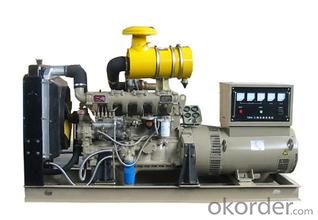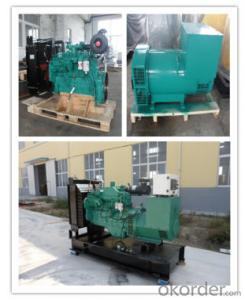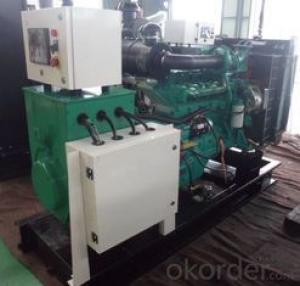1000Kw CE Approved Water-cooled Open Type Cummins Generator
- Loading Port:
- Shanghai
- Payment Terms:
- TT OR LC
- Min Order Qty:
- 1 set
- Supply Capability:
- 1000 set/month
OKorder Service Pledge
Quality Product, Order Online Tracking, Timely Delivery
OKorder Financial Service
Credit Rating, Credit Services, Credit Purchasing
You Might Also Like
1. Specifications
1.water-cooled cummins generator
2.open type generator
3.ce certificate
4.cummins OEM factory
2. 1000kw ce approved water-cooled open type cummins generator
| 1. Specification of genset | ||||||||
| Gensets model | KH-1000GF | |||||||
| Prime power | 1000kw | |||||||
| Rated Voltage | 400/230V | |||||||
| Rated frequency(HZ) | 50 | |||||||
| Rated Speed | 1500rpm | |||||||
| Power Factor | 0.8(lagging) | |||||||
| Dimensions(mm) (L×W×H) | 4950x2060x2350 | open type | ||||||
| Genset Weight(kg) | 12000 | |||||||
| 2. Specification of diesel engine | ||||||||
| Engine brand | Cummins | |||||||
| Engine model | KTA50-G3 | |||||||
| Number of Cylinders | 16 | |||||||
| Cylinder arrangement | Vertical in-line | |||||||
| Cycle | Four stroke | |||||||
| Aspiration | Turbocharged, Air/Water cooling | |||||||
| Fuel System | PT type fuel pump, EFC | |||||||
| Bore×Stroke (mm×mm) | 159 x 159 | |||||||
| Displacement (Liter) | 50.3 | |||||||
| Compression Ratio | 13.9:1 | |||||||
| Speed Governor | Electronic | |||||||
| Cooling System | Forced Water Cooling Cycle | |||||||
| Total lubrication system capacity (L) | 177 | |||||||
| Fuel Consumption at 100% Load (g/kw.h) | 197 | |||||||
| Starting Method | DC24V electrical starting | |||||||
| 3. Specification of alternator | ||||||||
| Alternator brand | Kaijieli(China-French joint venture Leory Somer technology) | |||||||
| Alternator model | TWGⅡ404G | |||||||
| Number of Phase | 3 | |||||||
| Connecting Type | 3 Phase and 4 Wires | |||||||
| Number of Bearing | 1 | |||||||
| Protection Grade | IP21 | |||||||
| Altitude | ≤1000m | |||||||
| Exciter Type | Brushless ,Self-exciting, AVR automatic voltage regulating,100% Copper winding wire | |||||||
| Insulation Class | H | |||||||
| Telephone Influence Factor (TIF) | ≤50 | |||||||
| THF | ≤2% | |||||||
| Voltage Regulation, Steady State | ≤±1% | |||||||
| Transient State Voltage | ≤-15%~+20% | |||||||
| 4. Specification of control Panel(with Kaixun controller) | ||||||||
| The control panel is AMF control panel, with the display of voltage,current, frequency, water temperature, oil pressure. The genset with low oil pressure,high water temperature,over speed,over load protection function. | ||||||||
| The features of Kaixun controller controller: | ||||||||
| Kaixun controller is a new generation Automatic control module for single Genset, which adopts bran-new outline configuration, focus on the requirements of customers, and perfectly improves the performance of controller. It fully meets the auto control requirements of different kinds of Genset for user or special assembly factory. | ||||||||

- Q: A couple years ago the power in our area was out for two whole weeks because of ice and such, we stayed warm thanks to gas heating but now I'm in an all electric mobile home in the same area. All I want to power is the refrigerator, deep freeze, microwave, one laptop and at least one, maybe two little plug in heaters.I need to know what size/type generator to get and if I need a separate kit or anything in order to hook up to my mobile home. I don't want to buy the wrong type or size and find out it doesn't work in the middle of an ice storm again.Thank you for any and all help, it's very much appreciated.
- Add up the wattage and look for the correct size to supply it.
- Q: engine is on a generator with about 800 hrs. changed fuel and fuel is getting to cylinder, pulled valve cover and valves are moving like they should, sprayed either in air intake and still no pop. any ideas other than to scrap the engine
- take it to a mechanic? how do you know there is fuel getting to the right spot? glow plugs?
- Q: I have a new Onan 10k diesel generator engine and an old isuzu pickup truck not worth engine replacement cost. Can this small diesel be adapted to fit the manual transmission?
- Probably not, no, as the diesel generator is designed to run an electrical load, not a mechanical.
- Q: i want to see the model of this perkins generating set
- That is the serial number for the engine only YD-35028- U-730936-F YD engine family 35028 parts list or sos number U country of manufacture in this case UK 730936 engine serial number F year of manufacturing Perkins Sold engines to many generator Manufacturers I can buy a Perkins engine and assemble a gen set with any available generator head and put (XTZ big bucks generator) on it for the name
- Q: i recently bought a reflux still it requires a 120 volt water pump to run it so my problem is i have the pump i just cant figure out how to get power i cannot use a gas or diesel generator cause it is to loud moon shining is illegal so the generator will get me caught i need a way to power the 120 volt water pump quietly and i don't got a lot of money in my budget so i need a way to power it for under a hundred dollars
- Your choices are limited. You can get a bunch of auto batteries and an inverter. How many batteries and the size of the inverter depends on the load of the pump, which you don't mention. Or a long extension cord.
- Q: Have a 15kw generator. Diesel. I want to upgrade without buying a whole new generator. Can I keep the motor and swap a generator hook up
- My best suggestion would be upgrade to Solar Photo Voltaic where you get output and also save diesel+ environment. or buy a second hand D.G .
- Q: fuel oil operated generator (called also heavy oil) can be a dual fuel engine e.g. fuel oil w diesel backup.engine only or a generator set.generator 150~250 Kvaif engine only: 200~300 HPused in working condition
- I dont get it are you buying selling or just telling us they exist.
- Q: can u give me a job description power plant operator using diesel ingine
- Diesel Motor turns a AC Generator. Diesel Motor turns a Water Pump, for Cooling.
- Q: I want to shut it inside a small room, but will it not suffocate ? Which part of the gen set should be moved out of the room ?
- Shuv somethin in the egsaust pipe
- Q: i have a plan to supply electric power supply to a colony of around 250 houses each have a load of approximately : 3 x1.5 ton air conditioners and all the other stuff of household use. voltage required is 400v 3 phase or 240 volt single phase. my question is if some one can please calculate the requirement of load for the above requirement and what size of generator is required for this load. thanks
- Here is a sample answer for gasoline generators to run a SINGLE HOUSEHOLD. Multiply the answer by 250 but just remember that diesel costs a lot more money. NorthStar Trifuel Generator — 614cc, 13,000 Surge Watts, 10,500 Rated Watts Fuel consumption is as follows: Gasoline:1.72 gallons per hour @full load. 1 gallon per hour @1/2 load. 1.72 gal @ $5 gal 41 gal $205 per day $1,435 7 days ($0.143 Minute) 1 gal @ $5 gal 24 gal $120 per day $840 7 days
Send your message to us
1000Kw CE Approved Water-cooled Open Type Cummins Generator
- Loading Port:
- Shanghai
- Payment Terms:
- TT OR LC
- Min Order Qty:
- 1 set
- Supply Capability:
- 1000 set/month
OKorder Service Pledge
Quality Product, Order Online Tracking, Timely Delivery
OKorder Financial Service
Credit Rating, Credit Services, Credit Purchasing
Similar products
Hot products
Hot Searches
Related keywords






























